Our History
Our Synagogue
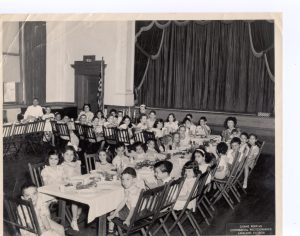 Sunday School Event, 1946
Sunday School Event, 1946
Temple Emanuel’s history is the history of Polk County and Central Florida more generally. As with the migration patterns of Jews around the world, the story begins with a peddler: Cyrus Wolfson arrived in Lakeland in 1909. By the time of the Florida boom in the 1920s, the number of families increased and informal celebrations began to take place with itinerant religious leaders. The first formal congregation, calling itself The Jewish Alliance, was formed during the depths of the depression (1932) when the founders purchased a small building from the Seventh Day Adventist Church on West Patterson Street and South New York Avenue. The “Ladies Auxiliary” sprung into action, forming a Sunday School and spearheading card nights open to the public to raise funds. Myer Cohen donated the first Torah to the Alliance, and in 1933, the community celebrated the first Lakeland bar mitzvah: Melvin Estroff. Most of the religious services were lay-led, using the talents of the congregation.
The group changed its name to Temple Emanuel sometime during the early 1940s, and in 1943, hired their first professional religious leader: Rabbi Jack Friedman. Rabbi Friedman conducted his first bar mitzvah, Gerald Rabin, shortly thereafter. During the war, congregants welcomed many of the soldiers stationed nearby — including Sam Pincus, who met his wife, Eva, when he came to visit family in Lakeland. The end of the war brought more local matches, such as Althea Sofness, who went on a blind date with Joe Miller when she came to visit her sister, Cele Stone.
Rabbi Sol Oster helped reshape the Temple’s school (c.1946), and Temple Emanuel grew. Support for the fledgling state of Israel included some clandestine fund-raising and the establishment of The Polk County Chapter of Hadassah (1947). B’nai B’rith Lodge #1515 is founded in 1944 and the women’s arm of the organization is a separate organization during the late 1940s and early 1950s.
By the end of the 1940s, the synagogue had outgrown its small space in Dixieland. Florida Southern College President Ludd Spivey sells the congregation a large home on Lake Hollingsworth which the synagogue renovates the space and relocates in 1949.
Rabbi Alexander Gelberman, the first rabbi to officiate at the new temple, oversaw many milestones, such as the first confirmation, the first bat mitzvah, and the establishment of a Jewish Cemetery on Highway 98 South.
Rabbi Samuel April (1956-1958) placed more emphasis on education—not just for children, but for adults. As early as 1955, a movement to build a new, larger Temple, designed professionally for that purpose, takes shape. Leonard Wolf headed up the building committee, with Harry Slakman and Melvin Estroff in charge of fundraising. The Temple was rocked when community opposition to the new construction blind-sides them at a zoning board meeting. The Temple’s request to obtain zoning board approval is held up for months. Congregants considered legal action, but the courage of Minister John L. Newton of the First Presbyterian Church in Lakeland silenced the opponents to our expansion in 1959.
Rabbi Herman Schwartz joined the congregation in 1959, adding Junior Congregation services on Shabbat mornings. Rabbi Irwin Cutler came to Lakeland in 1961 and officiated the ground-breaking ceremony for our new Temple building. A fire in April, 1964 destroyed the stately old mansion which was still being used for education classes. In its place, we built a modern Educational Youth Center, as Rabbi Aaron Shapiro took on the spiritual leadership of our congregation.
The addition of stained glass windows in the Temple Sanctuary and the Signer Board Room completed the work begun in 1964 by artist Joe Testa-Secca. Rabbi Louis Gorod assumed
our pulpit in 1969. In 1977, Rabbi Mordecai Levy became our spiritual leader and helped form the Men’s Club as another social and fund-raising arm of the congregation. Religious equality for women, including the recognition of women for aliyot and minyanim, the first adult b’nai mitzvah as well as the first full Shabbat morning bat mitzvah for a girl were all celebrated in the early 1980s. A few years later, members hired a second religious professional for education and cantorial responsibilities (Cantor Norman Golner, 1981-1986).
Rabbi Eliezer Ben-Yehuda arrived in August of 1986, bringing many innovations: he introduced us to the computer age, both in the office and in the Hebrew school; he created a new curriculum for the religious school; and took the congregation on its first group tour of Israel. The Temple employed part-time and short-term religious leaders in the years after Rabbi Ben-Yehuda’s departure (Rabbi Benjamin Shull, 1999-2000; Cantor Johanan Bickhardt, 2000-2001). Then, in September of 2001, Rabbi Eddie Fox came to Temple Emanuel, and built many bonds with the greater community—most notably his work with prisoners and the sick. Cantor Victor Geigner arrived in 2008, and assumed the role of spiritual leader of the congregation upon the death of Rabbi Fox later that year. Cantor Geigner initiated programs like The Afro-Semitic Experience, a concert which took place at the Branscomb Auditorium in 2009.
The education building was renovated in 2009, and began serving as more than just the religious school on Sundays: Renz Hall became the home of Saturday morning services and was used as a community center, with activities like movie nights, yoga classes and book club.
Rabbi Bertram Kieffer (2014 to 2016) brought exciting musical performances and support for Israel, while his wife, Dianne, created family programming that engaged all ages.
Our current spiritual leader, Rabbi David Goldstein (2016-present), has led us through hurricanes (Irma, in September 2017, destroyed part of the asbestos ceiling in the sanctuary; a bar mitzvah and High Holy Day services took place at the First Presbyterian church across the lake!), a pandemic and the attacks of October 7, 2023 in Israel. Rabbi Goldstein leads classes on diverse topics—from Jewish ethics to the study of less considered biblical texts—explores Jewish food and Israeli wines and trains the b’nai mitzvot of the congregation.
The myriad social events and religious observances that are part of our history are also part of our present: as a congregation, we are grateful for our rich past and our bright future.
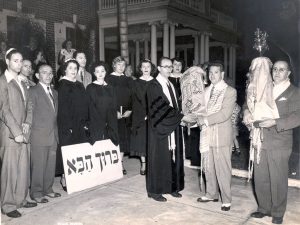 Temple Dedication, 1949
Temple Dedication, 1949 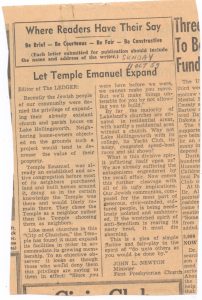 Newton Letter to Editor, Lakeland Ledger, 1959
Newton Letter to Editor, Lakeland Ledger, 1959 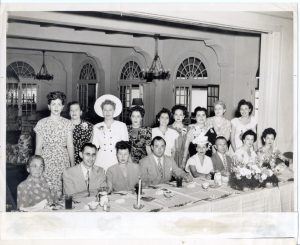 Temple Sisterhood and B’nai B’rith Installation, 1946
Temple Sisterhood and B’nai B’rith Installation, 1946
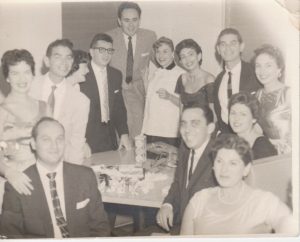 Young Couples at Temple Party, c.1950s
Young Couples at Temple Party, c.1950s
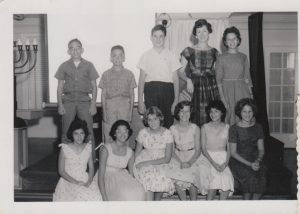 Mrs. Routenberg’s Sunday School Class, c.1955
Mrs. Routenberg’s Sunday School Class, c.1955
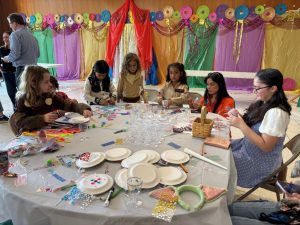 Purim Carnival, 2025
Purim Carnival, 2025
